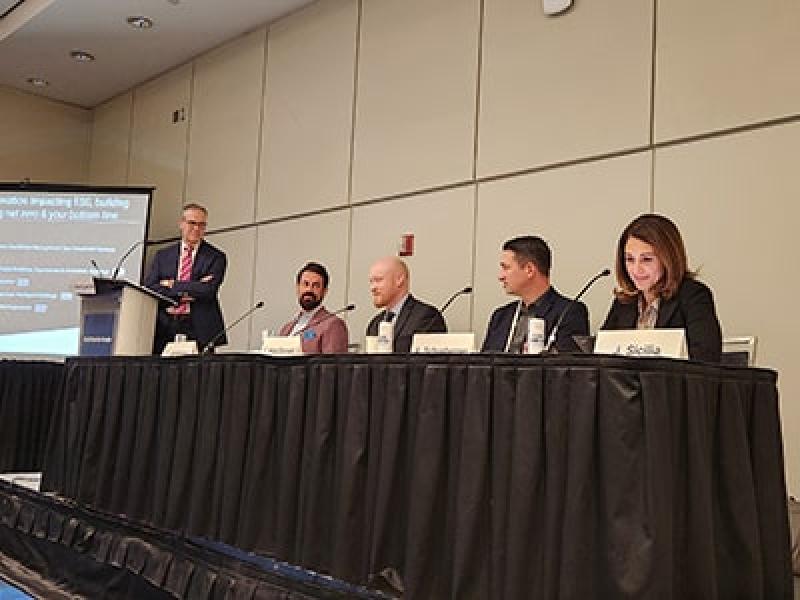
The real estate industry needs to move from vision to execution on its sustainability, ESG and net-zero goals.
That was the theme of one panel – How Technology & Innovation Is Impacting ESG, Building Performance, Achieving Net Zero And Your Bottom Line – at the Global Property Market (GPM) forum Nov. 29 in Toronto’s Metro Convention Centre.
“We work for a conservative industry, everyone wants to see some proof in the pudding,” said Andy Schonberger, vice president of client services at Intelligent Buildings. “They want to know who across the street has done this before exactly like this, exactly like me so that (they) can copy it.”
Other panelists were Fin MacDonald, a senior consultant at Urban Equation; Thano Lambrinos, senior vice president of buildings, experiences and innovation at QuadReal Property Group; and Jennifer Sicilia, chief operating officer at RYCOM Corporation.
The panel was moderated by Lachlan MacQuarrie, senior vice president of real estate management at Epic Investment Services.
Getting to net-zero
Speakers touched on the need for constant data to determine the best way to reduce emissions from building operations.
“In order to do those big moves, in order to enable that, you need data. The way we used to design buildings and the way some people still do, it was to oversize the heating plant,” MacDonald said. “Because that system was oversized, it always worked. Heat pumps don't work that way. The best way to find out what your actual heating demand is, is to measure.”
In discussing use cases for net-zero initiatives – such as low-carbon buildings – MacDonald noted the need to balance the necessary moves toward sustainability while being cost efficient. For example, switching to electricity from natural gas in Ontario is going to cost more.
The benefits to a series of small moves, as he puts it, are ensuring everything works optimally and making sure the operational team understands how the new technology works.
RYCOM's Sicilia offered an example, referencing work for Triovest on the Prologis complex in Mississauga. Starting in 2018, RYCOM implemented smart fault detection and diagnostics systems, which resulted in a reduction of 200.6 tonnes of carbon dioxide equivalent and annual total savings of $156,000.
Lambrinos talked about the integration of machine learning to leverage better control and save money. He referred to the installation of radar-based occupancy sensors in QuadReal’s office to regulate on-demand ventilation when people are, and are not, in the room.
“Nobody’s actively doing this in their buildings,” he said.
The discussion focused on going beyond the simple implementation of new technology.
“Why don't we look at real-time occupancy and start looking at comfort as the metric, more than just having things run, and we can communicate that back in operational savings to the tenants,” Lambrinos said. “So now we're talking about things that matter, not just technology.”
On pilot projects
While piloting is needed in order to rigorously test certain technologies and practices, there was also pushback on the idea that development needs the same piloting process.
“Pilot, but also stop piloting. Let's be real here. Everybody in this industry wants to be first to be second, right? So there's a number that have gone first,” Lambrinos said. “There's no use in piloting the things that we've already proven out. Some of our peers have already proven out connectivity as a foundation, normalizing data across your platform, integrating those datasets and starting to overlay analytics, even some of the most simple things.
“We piloted it, we're done, we can very clearly show what these results look like. Just do it.”
At the same time, getting to net-zero for a company’s building assets requires a plan, particularly in light of 2050 timelines. MacDonald said most buildings already have asset management plans that can be amended to accommodate larger innovations and energy reductions.
“I don't think that there's anything stopping anyone in this room from making a plan for their asset and starting to chip things away,” he said.
It’s acceptable to fail once in a while, as Sicilia explained while relating the story of a client who tried the same pilot on three different buildings with the same undesired result.
Risks in the ESG space
MacDonald pointed out one of the bigger issues is the availability of skilled labour to install, monitor and service cutting-edge products and systems.
“We're talking about having HVAC professionals that speak heat-pump language instead of boilers. Still, to this day, we're not teaching those things in trade school,” he said. “We also have a whole suite of options when it comes to HVAC.
"If your furnace breaks in your house, you can get a new furnace, like, the same day, but you're not going to get a heat pump installed. It’s the same thing in a commercial building setting.”
He also called electrifying heating the single biggest solution for reducing a building’s carbon emissions, but also the most complicated.
From Sicilia’s point of view, another risk is miscommunication and lack of messaging around what a company wants to achieve in sustainability and how that is articulated from a top-down perspective. Typically, she said, a head office will invest in some technologies and tell their sites to deploy them, but on-site staff don’t always have a lot of information about the technology.
When asked what they find exciting about the future, it's not one particular solution or technology. Instead, it's that technologies exist today which can help accomplish the end goals.
“What has me excited is the fact that a lot of these things are finally coming together and being utilized to deliver practical outcomes,” Lambrinos said. “(That) people and firms like ours, and several others, are actually doing stuff with all the technology that's been sat around for so long, that's worked, is what's very interesting.”










